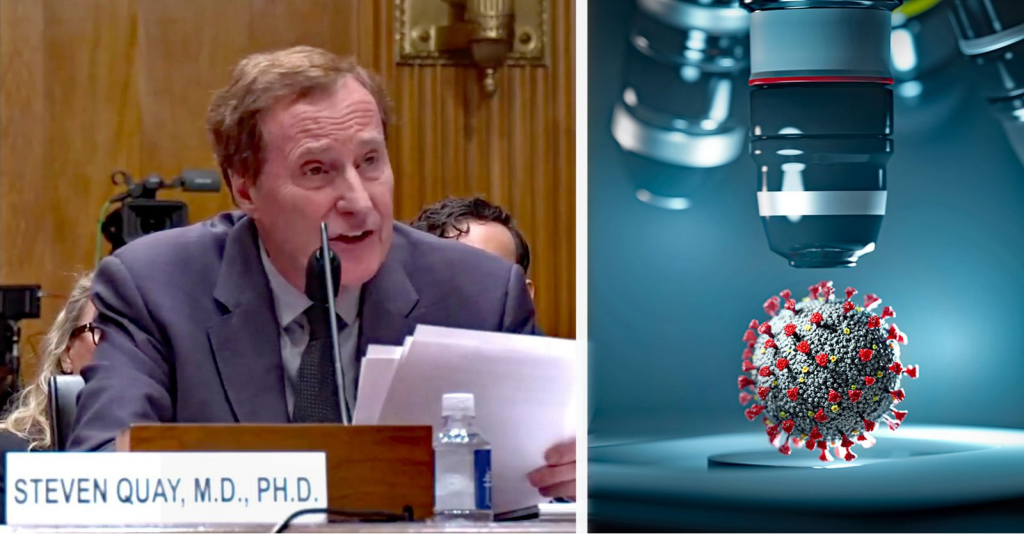







The COVID-19 lab-leak theory — far from being a myth or conspiracy theory — is supported by a “preponderance of evidence” U.S. senators today acknowledged in a historic bipartisan hearing.
Homeland Security and Governmental Affairs Chairman Gary Peters, a Democratic senator from Michigan, and ranking member Sen. Rand Paul (R-Ky.) led the two-hour committee hearing examining the available evidence on the origins of COVID-19. CHD.TV aired the hearing.
The Chinese government refuses to release key data from the Wuhan Institute of Virology from around the time COVID-19 emerged, making it difficult to assess the lab-leak theory and come to a conclusion.
Nonetheless, much evidence points toward a lab leak rather than a natural spillover from animals, according to both expert witnesses Steven C. Quay, M.D., Ph.D. — CEO of Atossa Therapeutics Inc. and former faculty member at Stanford University’s School of Medicine — and Richard H. Ebright, Ph.D., professor of chemistry and chemical biology and lab director at the Waksman Institute of Microbiology at Rutgers University.
Ebright is also on the leadership team of Biosafety Now, a nongovernmental organization that “advocates for reducing numbers of high-level biocontainment laboratories and for strengthening biosafety, biosecurity, and biorisk management for research on pathogens.”
‘1 in a billion’ chance COVID emerged from nature
Quay — who began by telling the committee he was speaking “as an independent scientist” with no relevant financial ties — explained that the genome of SARS-CoV-2 has seven features that would be expected to be found in a virus constructed in a laboratory and which are not found in viruses from nature.
“The statistical probability of finding each feature in nature can be determined,” Quay said, “and the combined probability that SARS2 came from nature is less than one in a billion.”
Ebright said his extensive research and gathering of documents likewise pointed toward a lab leak.
He also said the “gain-of-function” research on potentially dangerous pathogens — like the experiments underway at the Wuhan Institute when COVID-19 emerged — “has no civilian application” but is easy for researchers to do and make money doing.
“Researchers undertake it because it is fast,” Ebright said, “it is easy, it requires no specialized equipment or skills, and it was prioritized for funding and has been prioritized for publication by scientific journals.”
“These are major incentives to researchers worldwide, in China and in the U.S.,” he pointed out.
Moreover, gain-of-function research is largely unregulated, Ebright said.
There needs to be an independent agency that oversees and regulates this risky research, he said.
“Only after there is an acknowledgment,” Ebright said, “that there is a very real possibility — not a remote possibility, but a very real possibility — of a lab origin will there be the political will to impose regulation on this scientific community that has successfully resisted and obstructed regulation for two decades.”
Ebright added, “I see this acknowledgment today in a bipartisan fashion among members of this committee.”
When asked how important it is that legislators pass a law to regulate gain-of-function research, Ebright said it’s a “matter of survival.”
“It’s that important,” Ebright said. “There needs to be an entity that is independent of agencies that fund research and perform research to eliminate the structural conflict of interest that has existed with current self-regulation by agencies that perform and fund research.”
Paul said the committee will hold a hearing in the future focused on reforming gain-of-function research in the U.S.
Private comments don’t match public words
Attending committee members cited numerous instances in which federally funded researchers said one thing in private while saying something else in public.
For example, Sen. Josh Hawley (R-Mo.) called out Robert F. Garry, Ph.D., professor and associate dean of Tulane University’s School of Medicine — who gave expert testimony during the hearing — for being part of the “propaganda efforts” led by Dr. Anthony Fauci to suppress the lab-leak theory.
Garry co-authored the “Proximal Origin” paper, published on March 17, 2020, in Nature Medicine.
The paper — in which the authors concluded that SARS-CoV-2 was “not a laboratory construct or a purposefully manipulated virus” — was used by Fauci and Dr. Francis S. Collins to “tamp down” the idea that a lab leak caused the COVID-19 pandemic, reported The New York Times.
However, Garry expressed in a private email written close to the time the paper was written that he thought it unlikely the virus had natural origins, Hawley pointed out.
Ebright said he signed two petitions calling on Nature Medicine’s editors to review and retract the paper due to scientific misconduct.
The authors of the paper reported conclusions they knew at the time to be untrue. “This is the most egregious form of scientific misconduct,” Ebright said.
Hawley said, “People lost their jobs because of this. They lost their standing. They were kicked off Facebook. They were kicked off Twitter.”
Hawley asked Garry, “Do you regret being part of this effort, this propaganda effort?”
Garry said he was “just writing a paper about our scientific opinions.”
Hawley asked again: “Do you regret the fact that your paper was used to censor your fellow scientists? It was used to censor ordinary Americans who asked questions about the virus. Do you regret that?”
Garry said, “When you write a paper, I mean, you get it in the journal, we can’t control what happens.”
Hawley said, “So you’re not responsible at all. It’s amazing. Nobody who is involved in any of this is responsible.”
Later, Sen. Ron Johnson (R-Wis.) asked Garry how much money he had received in government grants over his career. “I’m not sure,” said Garry.
Johnson revealed that between 2020 and 2022, Garry and Kristian Andersen, Ph.D. — another co-author of the “Proximal Origin” paper — received $25.2 million in grants from the National Institutes of Health.
Multiple U.S. agencies concluded it was a lab leak
When Garry started to explain how the intelligence community came to the same conclusion as he and his co-authors, Hawley interrupted him. “That is a lie,” Hawley said. “Let’s stop there.”
Hawley pointed out that “multiple intelligence community agents and components” have concluded the virus was likely a lab leak.
The U.S. Department of Energy concluded COVID-19 came from a lab, Paul said. So did the FBI, he said.
A CIA whistleblower revealed that the scientists convened to study the issue voted 6-1 to say it came from the lab, Paul said. “Then they were overruled by superiors for political reasons.”
“So there’s a lot of evidence that people within the intelligence agencies actually do believe that there is evidence that it came from the lab,” Paul said.
Emily Kopp, a reporter with U.S. Right to Know, debunked more of Garry’s statements in an X post.
Johnson calls for unredacted copies of Fauci emails
Johnson held up copies of the final 50 pages of Fauci’s emails — which were heavily redacted. “We had to FOIA for these. They didn’t turn these over, which they should have.”
He suggested some are still looking for clear, conclusive evidence — as in a “smoking gun” — proving Fauci and the research he funded at the Wuhan Institute of Virology were responsible for the COVID-19 virus.
“My guess is the smoking gun exists somewhere under these heavy redactions,” Johnson said.
Johnson asked the chairman to issue a subpoena to get the final 50 pages unredacted.
Watch here:
“© [2024] Children’s Health Defense, Inc. This work is reproduced and distributed with the permission of Children’s Health Defense, Inc. Want to learn more from Children’s Health Defense? Sign up for free news and updates from Robert F. Kennedy, Jr. and the Children’s Health Defense. Your donation will help to support us in our efforts.






